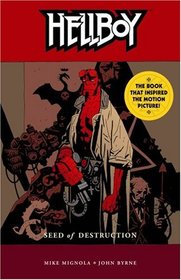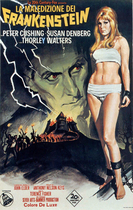Our editor-in-chief Nate Yapp is proud to have contributed to the new book Hidden Horror: A Celebration of 101 Underrated and Overlooked Fright Flicks, edited by Aaron Christensen. Another contributors include Anthony Timpone, B.J. Colangelo, Dave Alexander, Classic-Horror.com's own Robert C. Ring and John W. Bowen. Pick up a copy today from Amazon.com!
Cold Reads: Hellboy: Seed of Destruction by Mike Mignola and John Byrne
Here in the grim library section of Classic-Horror.com, I have thus far delved into written works of fiction both short and long. It is my mission to discuss varying mediums of the written word, everything from novels, plays, and comic books. This week's selection is the first in one of my mad experiments in the realm of the graphic arts.
Hellboy is somewhat of a cultural phenomenon. Starting out as a mere sketch by artist Mike Mignola, the character has developed and changed over the years since that first conception. Hellboy is now a force in the comic book industry to be reckoned with and one of the luminaries of the fabulous comic book company Dark Horse. Being no stranger to graphic novels, I eagerly awaited for the moment I could begin reading Hellboy: Seed of Destruction. As a fan of horror and comic books, I was sufficiently rewarded.
A squadron of U.S. troops is attempting to track down a gathering of nefarious Nazis who are planning on rendering a hole in time and space in order to bring about a force most foul. What they get instead is a child-like demon that ends up in the hands of the army. Fast forward fifty years and Hellboy is all grown up and is working for the Bureau for Paranormal Research and Defense. His mentor and father figure Professor Bruttenholm dies shortly after a mysterious rain of frogs and the appearance of an amphibious creature. This prompts Hellboy and his team of investigators to head into the legendary Cavendish House, a sinister abode doomed to sink under the waters of a lake. Beneath the dark and dank surface, Hellboy will encounter more horrors and a character from his past that may hold the answers to his true identity...
The first thing that immediately grabs your attention is the beautiful artwork of Mike Mignola. It somehow manages to be grungy, gothic, and classical all at once without seeming pretentious or strained in any way. The influence of the pulp mags of yesteryear on the art is quite clear, while the undertones of gritty Frank Miller-esque action can hardly be missed. With all these things going for him, Mignola scores high in my book. But don't let all these comparisons deter you. Mignola has a style all his own that is unique and instantly recognizable. The genius aspect of his creative hand is the melding of all these fond, nostalgic influences into something that is astoundingly fresh and compelling.
The storyline of the novel works in much the same way. Fans of the genre have undoubtedly become all too accustomed with evil Nazis with occult intentions on their twisted brains. Paranormal investigators who double as monsters are familiar faces as well. But all these tried plot conventions feel right at home within the world of Hellboy. You get the feeling that Mignola and writer John Byrne are saying "Yeah, we love all this old horror junk and we hope you do too."
Their love for the genre is evident in every panel and the fun they have running around in old stomping grounds permeates from each page. I mean how can you not love a Nazi general who has a swastika painted on his monocle? Or the ridiculously large and tentacled-monster that emerges from the earth ala Lovecraft's Cthulhu? And I hear tell that Mignola really loves drawing gorillas with bolts in their necks. That is pure devilish delight in the utmost degree of horror geekery, my friend.
However, the boys don't tread on self-parody and remember that they are making a horror comic. The beginning sets a dark and oppressive mood with the U.S. soldiers desperately waiting inside a rotting graveyard. The religious icons that are dispersed within this scene and others help to solidify that atmosphere of otherworldly terror. Most of the colors are muted in the story, especially during the time spent at the depressing Cavendish House. Hellboy's trademark scarlet skin seems to be the only thing with true vibrance in the artwork amongst all the dull colors by comparison. This helps to focus our attention on him at all times (rightfully so) and to remind us of the character's demonic origins.
Shadows and darkness cloak every page of the novel. They always seem to lurk about, slithering in the corners of the panel or covering the artwork in their inky embrace completely. The most effective use of this is demonstrated during the scenes when the character of Rasputin is present. The character seems to be a literal ghost from the past, flitting between each page like a spectral image. There's a really great effect done when Rasputin suddenly appears behind Mrs. Cavendish, his face emerging from the darkness as if from water. Another great moment is when the evil sorcerer is revealing Hellboy's destiny to him in the subterranean tunnels underneath Cavendish House. In one panel it appears as if Rasputin's robes are oozing across the ground and changing into contorted shadows. It's a simple yet marvelous piece of artwork that I actually had to sit back and admire for a few minutes.
My only minor contrivance with the book is the weird moment that occurs near the story's conclusion. As Hellboy is on the verge of defeat at the hands (and suckers) of his foes, we are suddenly transported to what looks like a bunch of aliens in a spaceship overseeing the battle. Where the hell did THAT come from? Is there some backstory to Hellboy involving these creatures that I missed out on? It seems unlikely; there were only a few appearances of Hellboy prior to this novel, and to my knowledge these guys didn't pop up randomly in those stories. This slight moment of "Umm... okay" was shortly replaced by a nice twist ending that involves more demons (heh heh) from Hellboy's past returning for more dirty deeds. Dun dun dun...
The novel is a great read overall, a feast for the eyes both art and narrative-wise. You could probably even do without the story and just let your eyes pore over the wonderfully dark art of Mignola for weeks on end. I highly anticipate the day I will be able to return to Mignola's work and that awesome character everyone knows and loves as Hellboy.









This sounds like a cool
This sounds like a cool illustrated novel and I think I might get it. going to the Chicago Comcon this year and it would be cool if dark horse had some stuff there.
I've always loved Hellboy and
I've always loved Hellboy and Mike Mignola's work on it. I'm happy to see you extend the reach of your focus to the graphical realm.
The aliens did seem out of place at first, but I think Mignola put them there to hint at the upcoming Hellboy story "The Conqueror Worm".
Chris Gaskey
http://chrisgaskey.tumblr.com
http://www.skyemag.com
http://www.facebook.com/chrisgaskey
http://www.twitter.com/chrisgaskey
As Chris Gaskey said above,
As Chris Gaskey said above, the aliens are a tease toward future stories. They do get explained later. Although /Hellboy/ can be read as a standalone graphic novel, it is also serial fiction.
Works like Mignola's Hellboy
Works like Mignola's Hellboy have been drawing me into the horror genre as a whole. You should also take a look at B.P.R.D. (Bureau for Paranormal Research and Defense). Those stories tend to be more linear and equally haunting.